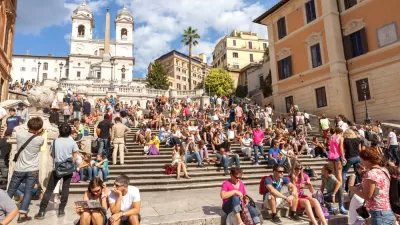With about 353 tourists per resident in the historic city center of Venice, many residents are fleeing the crowds and moving onto the mainland, making the city a "monument-attraction," rather than a viable living space.
As Marilena Mela writes for Global Site Plans, Italy is known for its stunning landscapes, rich culture, and mild climate, drawing about 46 million visitors every year. In many of the art cities featuring prominent works by influential artists, the influx of tourists in recent years is leading to a reevaluation of the tourism industry's benefits.
These visitors, many who are day-trippers or cruise-goers, "take a quick look at the canals and narrow roads, and return to their ship without contributing to the city’s economy. The touristic invasion, in combination with the flooding problem that continues to worsen, has led to an abandonment of the city center." Indeed, compared to other Italian cities, Venice and Rome host the greatest number of tourists, and a recent study by Sapienza Univeristy of Rome found “that the authentic character of the city is in danger of alteration, due to low quality facilities that represent a 'fast' tourism." In addition, "the overcrowding of the city center of Florence by tourists also seems to be a constant cause of stress for its inhabitants, as indicated by a 2012 study published in the journal Tourism Geographies."
With these impacts from tourism in mind, how can urban planners and architects use policies to minimize the detrimental affects and protect, but still showcase, historic cities?
Thanks to Renée van Staveren for the heads up.

Alabama: Trump Terminates Settlements for Black Communities Harmed By Raw Sewage
Trump deemed the landmark civil rights agreement “illegal DEI and environmental justice policy.”

Study: Maui’s Plan to Convert Vacation Rentals to Long-Term Housing Could Cause Nearly $1 Billion Economic Loss
The plan would reduce visitor accommodation by 25% resulting in 1,900 jobs lost.

Why Should We Subsidize Public Transportation?
Many public transit agencies face financial stress due to rising costs, declining fare revenue, and declining subsidies. Transit advocates must provide a strong business case for increasing public transit funding.

Paris Bike Boom Leads to Steep Drop in Air Pollution
The French city’s air quality has improved dramatically in the past 20 years, coinciding with a growth in cycling.

Why Housing Costs More to Build in California Than in Texas
Hard costs like labor and materials combined with ‘soft’ costs such as permitting make building in the San Francisco Bay Area almost three times as costly as in Texas cities.

San Diego County Sees a Rise in Urban Coyotes
San Diego County experiences a rise in urban coyotes, as sightings become prevalent throughout its urban neighbourhoods and surrounding areas.
Urban Design for Planners 1: Software Tools
This six-course series explores essential urban design concepts using open source software and equips planners with the tools they need to participate fully in the urban design process.
Planning for Universal Design
Learn the tools for implementing Universal Design in planning regulations.
Smith Gee Studio
Alamo Area Metropolitan Planning Organization
City of Santa Clarita
Institute for Housing and Urban Development Studies (IHS)
City of Grandview
Harvard GSD Executive Education
Toledo-Lucas County Plan Commissions
Salt Lake City
NYU Wagner Graduate School of Public Service



























